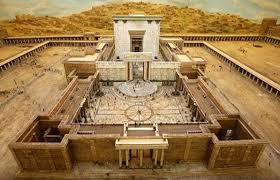

In that day the branch of the LORD shall be beautiful and glorious, and the fruit of the land shall be the pride and glory of the survivors of Israel. And he who is left in Zion and remains in Jerusalem will be called holy, every one who has been recorded for life in Jerusalem, when the Lord shall have washed away the filth of the daughters of Zion and cleansed the bloodstains of Jerusalem from its midst by a spirit of judgment and by a spirit of burning. Then the LORD will create over the whole site of Mount Zion and over her assemblies a cloud by day, and smoke and the shining of a flaming fire by night; for over all the glory there will be a canopy and a pavilion. It will be for a shade by day from the heat, and for a refuge and a shelter from the storm and rain. (Isaiah 4:2-6)
This paper speculates on the Temple of Ezekiel
described by that prophet, as understood from a Christian point
of view. That building has never yet been built. A straightforward
literal interpretation of Ezekiel is assumed.
Two temples of Yahweh have been located on the Temple Mount in
Jerusalem in times past. Solomon's Temple called by the Jews,
the "First Temple" was destroyed by the siege of Nebuchadnezzar
and the armies of Babylon on the 9th of Av in 586 BC. Some seventy
years later, approximately, Jewish exiles were allowed to return
to Jerusalem to build an altar, the "Second" Jewish
temple, and finally the walls of the city. Although modest in
comparison to the First Temple, the Second Temple was later greatly
enlarged and expanded by Herod the Great. This latter temple was
the Temple in which Jesus was dedicated, and where He taught and
cast out the money changers on two occasions.
The Day of Pentecost following the resurrection of Jesus, found
Jewish believers assembled for prayer in the temple courts (Acts
2). There the Holy Spirit came from heaven to begin the calling
out of a new group of believers (both Jews and Gentiles) -- a
body now known as the church of Jesus Christ. Preaching by the
Apostles and public miracles recorded in the book of Acts took
place in the courts just outside this Second Temple. But the now-magnificent
Second Temple was destroyed by General Titus and besieging Roman
armies on the 9th of Av in AD 70. This destruction had been predicted
by Jesus earlier (see Matthew 24, Luke 21). Since AD 70 no Jewish
temple has been built on the Temple Mount, therefore no blood
sacrifices for sin have been possible for religious Jews, up to
the present day.
The New Testament contains three references to a Third Jewish
Temple standing on the site at the end of the present age. Likewise
there are Scriptural reasons (Christians believe) that a the coming
Third Temple will be followed by a Fourth. The location of the
First and Second Temples is a matter of keen interest among devout
Jews in Israel today as the Third Temple must be built on the
consecrated ground of the Temple Mount in Jerusalem where the
First and Second Temples stood. This site is currently under the
control of the Muslim WAQF. This article concerns primarily the
Fourth Temple, usually called "Ezekiel's Temple.
Only a small number of Orthodox Jewish believers
in Israel today believe that the coming Third Temple will be built
by the Jewish Messiah when he appears. Groups such as The
Temple Institute believe it is incumbent upon them to make all
possible preparations in advance - and to build the Third Temple
when the freedom to do so is gained on the Temple Mount - whether
or not the Messiah arrives before or after a Third Temple is erected.
The post-exilic prophet Zechariah (who wrote around the year 500
BC) says that Messiah, whom he calls the "Branch" would
Himself one day build a temple in Israel. The Branch will be an
individual in whom the offices of both King and High Priest
are combined:
"Take from them (the returning exiles from Babylon) silver and gold, and make a crown, and set it upon the head of (Yeshua) Joshua, the son of Jehozadak, the high priest, and say to him, 'Thus says the Lord of hosts, "Behold, the man whose name is the Branch: for he shall grow up in his place, and he shall build the temple of the Lord. It is he who shall build the temple of the Lord, and shall bear royal honor, and shall sit and rule upon his throne. And there shall be a priest by his throne, and peaceful understanding shall be between them both."' (Zechariah 6:13.)
Christians believe that the promised Messiah,
Jesus (Yeshua), has already come to earth once--and will come
a second time to establish his millennial kingdom on the earth,
ruling thereafter from Jerusalem from the throne of His forefather
King David. The New Testament Epistle to the Hebrews describes
the once-for-all, fully-efficacious, blood sacrifice of Jesus
as the true Lamb of God. In contrast, the animal sacrifices of
the Old Covenant were but shadows pointing to Messiah's coming.
Although the New Testament speaks three times of the existence
of a Third Jewish Temple in Jerusalem at the end of the present
age, as we have already discussed, the fate of that Third Temple
is not given in the New Testament.
A great and devastating earthquake is associated with the second
coming of Jesus to the Mount of Olives which apparently will destroy
most of the city of Jerusalem at that time. Major topographic
changes will occur throughout the land of Israel as well.
These changes in the entire land when Messiah comes are spoken
of in numerous passages of the Bible:
Thus it is reasonable to suppose that the Third
Temple will be destroyed by the final earthquake at Messiah's
appearing in glory, or by the final military invasion of Jerusalem
during World War III spoken of also by Zechariah in the above
passage.
The prophet Ezekiel (Ezekiel 40-48) describes in great detail
a temple in Israel that is much too large to fit on the present
Temple Mount site. The Temple of Ezekiel proper measures about
875 feet square, and it sits in the middle of a large consecrated
area (See inset in diagram below). Ezekiel's temple is also very
different in many details from any previous temples that have
existed in Israel (or elsewhere). Therefore most Bible scholars
believe there will one day exist in the Holy Land a Fourth or
"Millennial" Temple.
Ezekiel also describes the reapportionment of the land in specific
lots during the millennial kingdom. The temple and the temple
district are not part of the rebuilt city of Jerusalem according
to the details of this reapportionment. Note that the Temple area
will be located to the North of rebuilt Jerusalem:
"When you allot the land as a possession, you shall set apart for the Lord a portion of the land as a holy district, twenty-five thousand cubits long and twenty thousand cubits broad; it shall be holy throughout its whole extent. Of this a square plot of five hundred by five hundred cubits shall be for the sanctuary, with fifty cubits for an open space around it. And in the holy district you shall measure off a section twenty-five thousand cubits long and ten thousand broad, in which shall be the sanctuary, the most holy place. It shall be the holy portion of the land; it shall be for the priests, who minister in the sanctuary and approach the Lord to minister to him; and it shall be a place for their houses and a holy place for the sanctuary. Another section, twenty-five thousand cubits long and ten thousand cubits broad, shall be for the Levites who minister at the temple, as their possession for cities to live in."
"Alongside the portion set apart as the holy district you shall assign for the possession of the city an area five thousand cubits broad, and twenty-five thousand cubits long it shall belong to the whole house of Israel."
"And to the prince shall belong the land on both sides of the holy district and the property of the city, on the west and on the east, corresponding in length to one of the tribal portions, and extending from the western to the eastern boundary of the land. It is to be his property in Israel. And my princes shall no more oppress my people; but they shall let the house of Israel have the land according to their tribes." (Ezekiel 45:1-8.)
"Adjoining the territory of Judah, from the east side to the west, shall be the portion which you shall set apart, twenty-five thousand cubits in breadth, and in length equal to one of the tribal portions, from the east side to the west, with the sanctuary in the midst of it. The portion which you shall set apart for the Lord shall be twenty-five thousand cubits in length, and twenty thousand in breadth." (Ezekiel 48)
According to many Christian Bible scholars,
the Fourth Temple (Ezekiel 40-45) will be "memorial"
- a teaching center apparently to instruct men about the holiness
of God and proper worship during the coming kingdom of Jesus on
the earth. As sinful men and women continue to be born into the
world in the millennium, the temple is supposed to remind everyone
of the substitutionary death of Jesus on the cross, as the "Lamb
of God," some two thousand years earlier.
Although Ezekiel is a much-neglected book, several good commentaries
(Ref. 1, 2) complete with detailed
analysis of the chapters on the Millennial temple are in print.
In addition Mr. John W. Schmitt of Portland, Oregon (Ref. 3) has
devoted many years to a study of Ezekiel's Temple, and to the
construction of several fine scale models used for educational
purposes.
Ezekiel had planned to enter the priestly service in the First
Temple when he reached thirty years of age. His plans were cut
short in 597 when King Nebuchadnezzar raided and captured Jerusalem
after a brief siege, taking with him young king Jehoichin and
"all the princes, and all the mighty men of valor, ten thousand
captives, and all the craftsmen and smiths." (2 Kings 24:14).
(By way of reference, Daniel and his three friends of the tribe
of Judah plus others from Jerusalem had previously been taken
to Babylon in a raid by General - soon to be King - Nebuchadnezzar
after the battle of Carchemish in 605. That famous battle ended
the rule of Egypt in the ancient world).
In the fifth year of his own exile from Jerusalem, that is in
593 BC, Ezekiel was called by God to exercise a prophetic ministry
to the house of Israel which he continued until about the year
570. Ezekiel was married, in fact his wife died as a sign from
God on the day the siege of Jerusalem began, (24:18).
Ezekiel's temple and the millennium occupies the last eight long
chapters of his book. He gives 318 precise measurements of the
temple using some 37 unique words that are architectural terms,
such as "door-posts," "windows," etc. Ezekiel
received this great wealth of information on the millennial temple
in the year 573 BC in the form of a vision and a personally conducted
tour of the temple by "a man whose appearance was like the
appearance of bronze." (Evidently the Angel of the
Lord). "He had a line of flax and a measuring rod in his
hand and he stood in the gateway." (40:3) The tour began
at the Eastern Gate - which was closed:
"Then he brought me back to the outer gate of the sanctuary, which faces east; and it was shut. And he said to me, "This gate shall remain shut; it shall not be opened, and no one shall enter by it; for the LORD, the God of Israel, has entered by it; therefore it shall remain shut. Only the prince may sit in it to eat bread before the LORD; he shall enter by way of the vestibule of the gate, and shall go out by the same way." (44:1-3)
The present Golden Gate in the Eastern Wall
of the Temple Mount in Jerusalem is walled shut. Jewish and Arab
tradition teaches - probably because of a misinterpretation of
this passage in Ezekiel - that the Jewish Messiah is to enter
the Golden Gate. For that reason the gate was walled up by the
Arabs in the 11th Century after the Crusades, (if not earlier)
or perhaps by Suleiman the Magnificent in AD 1539-1542 - to prevent
the Jewish Messiah from entering. The much older gate beneath
the present Golden Gate, or else another (as yet undiscovered)
gate in the Eastern wall could have been the one used by Jesus
when He rode into Jerusalem on Palm Sunday riding on the foal
of a donkey.
In addition to being a very large and complex structure Ezekiel's
temple differs in several very important ways from any previously
existing Jewish temple. These have been catalogued by researcher
John Schmitt, a Portland, Oregon Bible scholar, as follows:
If the previous temples, as well as the Tabernacle
of Moses, are pictures for us of man as the dwelling place of
God, then Ezekiel's temple may be intended to teach us about the
marvelously new resurrection bodies waiting for every believer
when he leaves this present life (2 Corinthians 5:1-5).
Believing saints from the Old Testament epoch, saints from the
Christian era, and all those raised from the dead at the rapture
and at the second coming of Christ in glory receive new resurrection
bodies, like that of Jesus, as detailed in 1 Corinthians 15. Yet,
after the Battle of Armageddon, Jesus will gather all the survivors
of the nations outside Jerusalem and determine which individual
sons and daughters of Adam are worthy to enter the Millennial
Kingdom on earth. This is the famous judgment of the sheep and
the goats described by our Lord in Matthew 25:31-46, and also
given by the prophet Joel:
The criterion for judgment at this time will be how individuals Gentiles have treated the Jews, especially believing Jews who constitute "true Israel." The "Sheep" category clearly represents those righteous gentiles whose hearts are right before the Lord, that is they are all regenerated men and women, but individuals who have not previously received their resurrection bodies. They will repopulate the earth, according to Christian belief, during the thousand year reign of Messiah under greatly improved living conditions:
"But be glad and rejoice for ever in that which I create; for behold, I create Jerusalem a rejoicing, and her people a joy. I will rejoice in Jerusalem, and be glad in my people; no more shall be heard in it the sound of weeping and the cry of distress. No more shall there be in it an infant that lives but a few days, or an old man who does not fill out his days, for the child shall die a hundred years old, and the sinner a hundred years old shall be accursed. They shall build houses and inhabit them; they shall plant vineyards and eat their fruit. They shall not build and another inhabit; they shall not plant and another eat; for like the days of a tree shall the days of my people be, and my chosen shall long enjoy the work of their hands. They shall not labor in vain, or bear children for calamity; for they shall be the offspring of the blessed of the LORD, and their children with them. Before they call I will answer, while they are yet speaking I will hear. The wolf and the lamb shall feed together, the lion shall eat straw like the ox; and dust shall be the serpent's food. They shall not hurt or destroy in all my holy mountain, says the LORD." (Isaiah 65:18-25)
During this thousand year reign of Yeshua over a restored earth, with Satan locked away in the abyss (Rev. 20:2), sinners will be born on the earth and will need to be instructed in matters of God's grace and mercy. For this reason most commentators on Ezekiel believe that the Fourth Temple will be Memorial in nature, looking back in time to the cross of Jesus Christ, just as the Tabernacle and First and Second Temples pointed ahead in time to the cross. The prescribed worship services of Ezekiel's temple are also described for us in great detail by the prophet. The priests presiding over the temple services will be of the line of Zadok (44:15) who proved faithful after the failure of the Levitical priests in the line of Eli (1 Samuel 2:35, 1 Kings 2:26-27, 35). The Millennial Temple will not have a separate High Priest. Instead the previously separate ofiices of King and Priest will be combined in the Messiah as noted, (See Zechariah 6:9-15)
Approximate Distribution of Land to the Twelve Tribes
during Messiah's Coming Reign
In addition to the physical differences in
Ezekiel's Temple a number of changes are made in the annual cycle
of Jewish feasts. It is very clearly that the Millennial Temple
sacrifices are definitely not a re-instatement of the Mosaic system,
(see Ref. 4).
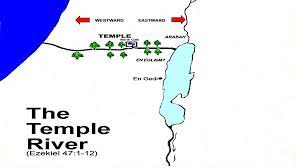 Another feature of the Millennial Temple is the presence of a
great stream of fresh water which issues from beneath the Southern
wall of the Temple. Ezekiel describes this river, which divides
into two branches and flows Westward into the Mediterranean Sea
and also Eastward into the Northern end of the Dead Sea, freshening
all the land South of Jericho,
Another feature of the Millennial Temple is the presence of a
great stream of fresh water which issues from beneath the Southern
wall of the Temple. Ezekiel describes this river, which divides
into two branches and flows Westward into the Mediterranean Sea
and also Eastward into the Northern end of the Dead Sea, freshening
all the land South of Jericho,
Then he brought me back to the door of the temple; and behold, water was issuing from below the threshold of the temple toward the east (for the temple faced east); and the water was flowing down from below the south end of the threshold of the temple, south of the altar. Then he brought me out by way of the north gate, and led me round on the outside to the outer gate, that faces toward the east; and the water was coming out on the south side. Going on eastward with a line in his hand, the man measured a thousand cubits, and then led me through the water; and it was ankle-deep. Again he measured a thousand, and led me through the water; and it was knee-deep. Again he measured a thousand, and led me through the water; and it was up to the loins. Again he measured a thousand, and it was a river that I could not pass through, for the water had risen; it was deep enough to swim in, a river that could not be passed through.
And he said to me, "Son of man, have you seen this?" Then he led me back along the bank of the river. As I went back, I saw upon the bank of the river very many trees on the one side and on the other. And he said to me, "This water flows toward the eastern region and goes down into the Arabah; and when it enters the stagnant waters of the sea, the water will become fresh. And wherever the river goes every living creature which swarms will live, and there will be very many fish; for this water goes there, that the waters of the sea may become fresh; so everything will live where the river goes. Fishermen will stand beside the sea; from Engedi to Eneglaim it will be a place for the spreading of nets; its fish will be of very many kinds, like the fish of the Great Sea. But its swamps and marshes will not become fresh; they are to be left for salt. And on the banks, on both sides of the river, there will grow all kinds of trees for food. Their leaves will not wither nor their fruit fail, but they will bear fresh fruit every month, because the water for them flows from the sanctuary. Their fruit will be for food, and their leaves for healing." (47:1-12)
This same stream of water seems to be identical
to that described in Zechariah 14:8 and Joel 3:18. If so then
the site of the Fourth Temple would seem to be on or near the
present Temple Mount in Jerusalem. If this is so, then the city
of Jerusalem will evidently be rebuilt to the South since the
temple holy district is specified in Ezekiel 48 as North of the
rebuilt city of Jerusalem. Some commentators have suggested that
the Millennial Temple will be located at Shiloh, 31 kilometers
to the North of present day Jerusalem.
A second reason for believing that the site of Ezekiel's Temple
may be near the present Temple Mount is found in Ezekiel's description
of the return of the Lord to dwell forever with His people Israel.
The Lord says the people will no longer defile the temple site
with the dead bodies of their kings. Since there are so many cemeteries
on and around the Temple Mount this would require a special ritual
cleansing of the entire area (described by Ezekiel), and of course
the relocation of the rebuilt City to the South of the Temple
district as we have already noted:
Afterward he (the angel of the Lord brought me (Ezekiel) to the gate, the gate facing east. And behold, the glory of the God of Israel came from the east; and the sound of his coming was like the sound of many waters; and the earth shone with his glory. And the vision I saw was like the vision which I had seen when he came to destroy the city, and like the vision which I had seen by the river Chebar; and I fell upon my face. As the glory of the LORD entered the temple by the gate facing east, the Spirit lifted me up, and brought me into the inner court; and behold, the glory of the LORD filled the temple. While the man was standing beside me, I heard one speaking to me out of the temple; and he said to me, "Son of man, this is the place of my throne and the place of the soles of my feet, where I will dwell in the midst of the people of Israel for ever.
And the house of Israel shall no more defile my holy name, neither they, nor their kings, by their harlotry, and by the dead bodies of their kings, by setting their threshold by my threshold and their doorposts beside my doorposts, with only a wall between me and them. They have defiled my holy name by their abominations which they have committed, so I have consumed them in my anger. Now let them put away their idolatry and the dead bodies of their kings far from me, and I will dwell in their midst for ever. "And you, son of man, describe to the house of Israel the temple and its appearance and plan, that they may be ashamed of their iniquities. And if they are ashamed of all that they have done, portray the temple, its arrangement, its exits and its entrances, and its whole form; and make known to them all its ordinances and all its laws; and write it down in their sight, so that they may observe and perform all its laws and all its ordinances. This is the law of the temple: the whole territory round about upon the top of the mountain shall be most holy. Behold, this is the law of the temple. (Ezekiel 43:1-12)
Jerusalem, the rebuilt city in Israel, on earth,
during the Millennium, should not be confused with the heavenly
city known as "New Jerusalem," referred to in the New
Testament, (Hebrews 11:16, 12: 18-29, Revelation 21-22) which
seems to take the form of a great orbiting or stationary satellite
above the earth. This vast city whose dimensions are of the order
of 1500 miles on a side, may be connected to the millennial temple
by a space-time gate way. The New Jerusalem does not include a
temple (Revelation 21:22, 23) - "The Lord God, the Almighty
and the Lamb, are its temple."
During the millennial kingdom sin will continue to exist on the
earth, but all forms of defilement and sin are clearly excluded
from the New Jerusalem, and guarded against by the complex rituals
proscribed for the Temple of Ezekiel on the earth.
Ezekiel saw in a great vision the departure of the glory (the
shekinah) of God from the Temple of Solomon, (Ezekiel 9:1-11:25).
In a subsequent vision of Jersualem in 573 BC, eighteeen years
later, Ezekiel was shown the future return of the Shekinah to
Israel and to the Temple (43:1-12). That future day had also been
forseen by the prophet Isaiah:
In that day the Branch of the LORD shall be beautiful and glorious; And the fruit of the earth shall be excellent and appealing For those of Israel who have escaped. And it shall come to pass that he who is left in Zion and remains in Jerusalem will be called holy--everyone who is recorded among the living in Jerusalem. When the Lord has washed away the filth of the daughters of Zion, and purged the blood of Jerusalem from her midst, by the spirit of judgment and by the spirit of burning, then the LORD will create above every dwelling place of Mount Zion, and above her assemblies, a cloud and smoke by day and the shining of a flaming fire by night. For over all the glory there will be a covering. And there will be a tabernacle for shade in the daytime from the heat, for a place of refuge, and for a shelter from storm and rain. (Isaiah 4:2-6)
Although we are given much information in the Bible on Tabernacle and Temples, the principal Biblical emphasis is not on buildings but on men and their character, scripture does not negate the use of shadows and symbols.
"Thus says the Lord: 'Heaven is my throne and the earth is my footstool; what is the house which you would build for me, and what is the place of my rest. All these things my hand has made, and so all these things are mine, says the Lord. But this is the man to whom I look, he that is humble and contrite in spirit and trembles at my word."' (Isaiah 66:1, 2)
![]()
Other Relevant Diagrams
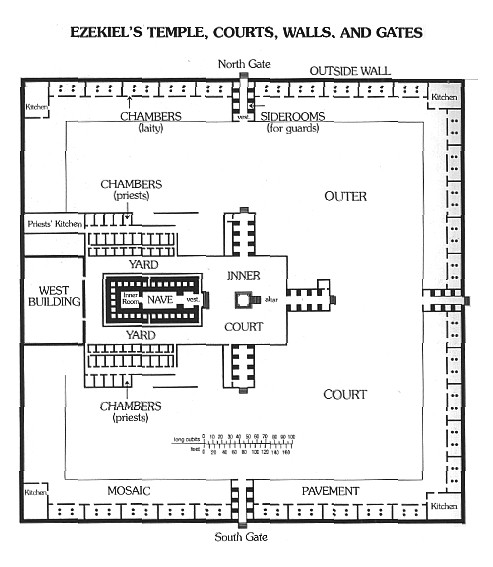
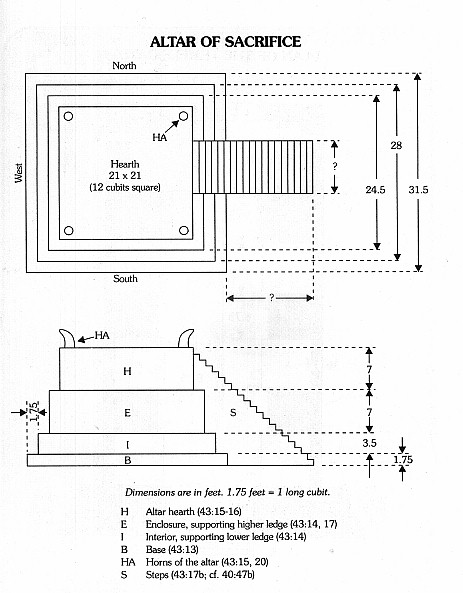
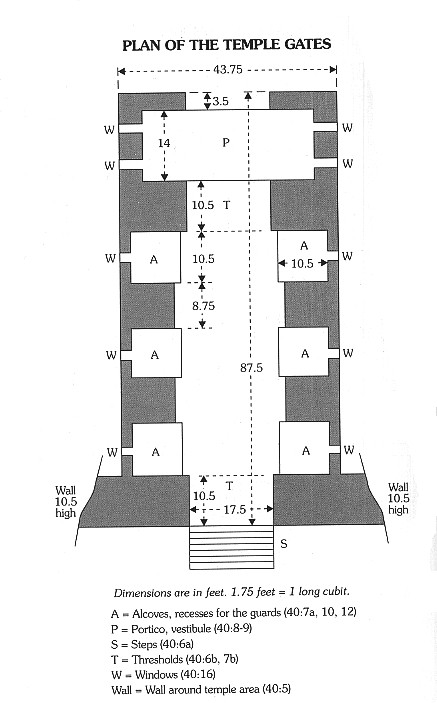
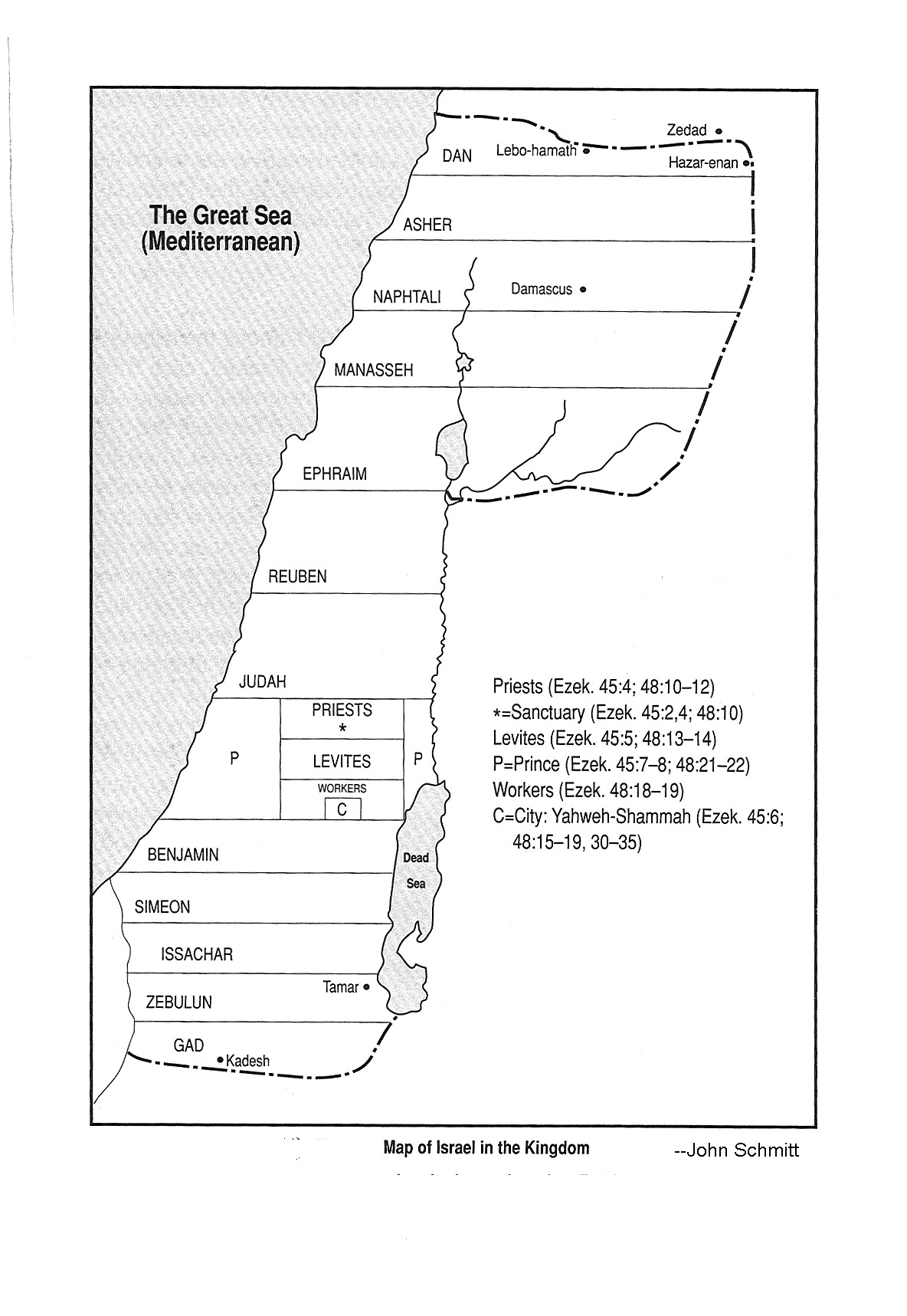
1.
Ezekiel, by Ralph Alexander, Moody Press, Chicago,
1976.
2. Ezekiel,
by John B. Taylor, Tyndale Old Testament Commentaries, Intervarsity
Press, Downers Grove, Illinois, 60515, 1969.
3. John W.
Schmitt, Messianic Temple Ministries, 1633 SE 38th
Portland, OR 97233. (John Schmitt was a speaker at one of our conferences
on the Temple Mount several years ago in Jerusalem. He spoke at
that session on Ezekiel's Temple. He is from Portland and had
built several models of Ezekiel temple and for some years was
presenting his model at churches in his area. Photo: http://www.pauljab.net/temple/Johnsmodel.html.
I (LTD) have known John many years and encouraged him, when we
first got acquainted, to travel to Israel and I urged him to write
a book. He is the only one I know who writes these days on Ezekiel's
yet-to-be-built temple, so his research is much needed. At last
John's book is out and is one you will want in your library: Messiah's
Coming Temple: Ezekiel's Prophetic Vision of the Future Temple
by John W. Schmitt and J. Carl Laney Kregel Publications,
Grand Rapids, MI 1997. 188 pages, paperback, about $11.00. See
also The Millennial Temple,
by Paul Jablonowski
4. Israelology:
The Missing Link in Systemic Theology, by Arnold G. Fruchenbaum,
Ariel Ministries Press, Box 3723, Tustin, CA 92681, 1992.
4. A correspondent has noted that Ezekiel's cubit was not the
normal 18 inch cubit, but a long cubit, 20.679 (or 21) inches.
The reed in Ezekiel was 6 long cubits in length.
![]()
The Temple of Ezekiel
by Lambert Dolphin
Email: lambert@ldolphin.org
Web Pages: http://ldolphin.org/
Revised May 31, 1995, April 19, 1996, January 18, 1997, November 7, 1997. March 1, 2000. December 4, 2001. July 14, 2002. July 13, 2004. July 19, 2021.
